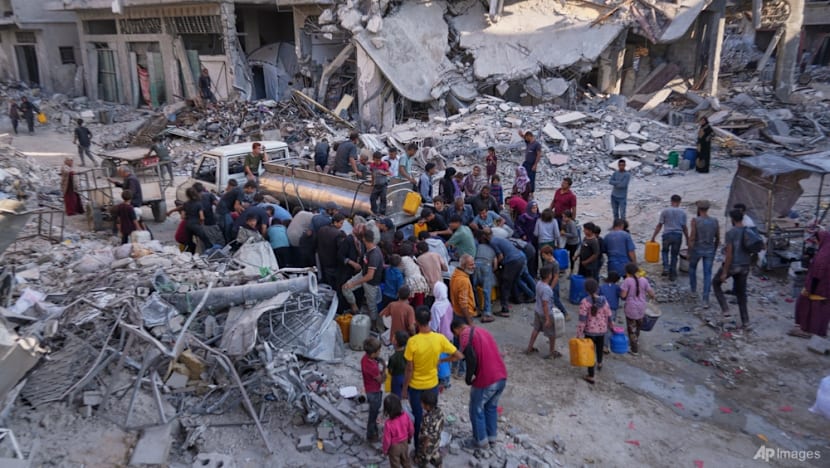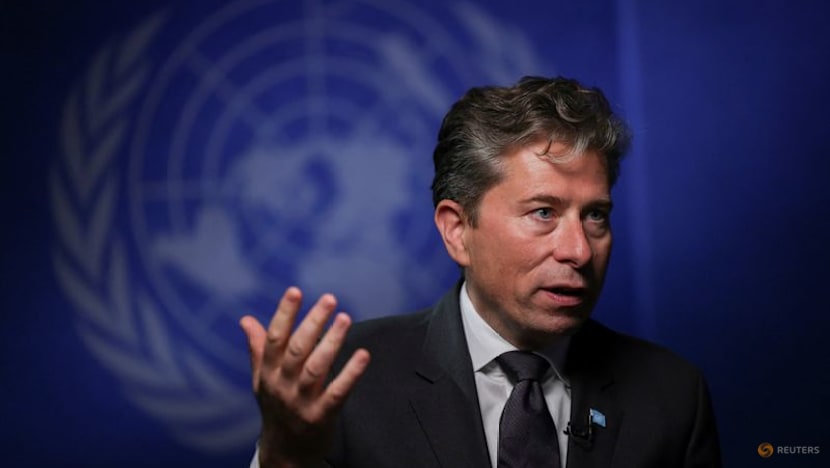UN aid chief foresees ‘massive job’ ahead on tour of ruined Gaza
Restoring Gaza’s devastated infrastructure and dignity for its people would be a “massive, massive job”, said Tom Fletcher.

JERUSALEM: The United Nations’ humanitarian chief Tom Fletcher said on Saturday (Oct 18) that restoring Gaza’s devastated infrastructure and dignity for its people would be a “massive, massive job”, as he toured wrecked neighbourhoods in the war-torn enclave.
Fletcher, accompanied by a UN convoy, visited a wastewater treatment plant in Sheikh Radwan, north of Gaza City, where raw sewage had pooled among the ruins.
“I drove through here seven to eight months ago when most of these buildings were still standing,” he told AFP. “To see the devastation — this is a vast part of the city, just a wasteland — and it’s absolutely devastating.”
The densely populated Gaza Strip, home to more than two million people, has been left in ruins after two years of bombardment and ground fighting between Israel and Hamas.
AID FLOWING BUT BORDERS STILL CLOSED
More than a week after US President Donald Trump brokered a truce, the main Rafah crossing to Egypt remains closed, but hundreds of aid trucks have entered Gaza daily via Israeli checkpoints.
According to UN figures, about 950 trucks carrying food, fuel and commercial goods entered Gaza from Israel on Thursday. Fletcher said UN agencies were planning a 60-day emergency programme to ramp up relief.
“We’ve got to get the power back on, get the sanitation system back, surge in food, get a million meals out a day, start to rebuild the health sector, bring in tents for the winter, and get kids back into school,” he said.
Residents returning to their destroyed homes were digging makeshift latrines, he said. “They’re telling me most of all they want dignity.”
Relief groups have urged Israel to reopen Rafah to accelerate deliveries, while Turkey has positioned rescue teams at the border to help retrieve bodies from the rubble.

DEADLY INCIDENT DESPITE TRUCE
Despite the ceasefire, Gaza’s civil defence agency said Israeli fire killed nine Palestinians that included four children. This happened when two tank shells struck a family bus in Gaza City on Saturday.
Two more victims were missing and presumed dead, officials said.
At Al-Ahli Hospital, the victims’ bodies were wrapped in white shrouds as relatives wept.
“My daughter, her children and her husband; my son, his children and his wife were killed. What did they do wrong?” asked Umm Mohammed Shaaban, a grieving grandmother. “There is no truce.”
The Israeli military said its troops fired on a vehicle that approached the “yellow line”, the boundary Israeli forces withdrew to under the truce and claimed it posed an “imminent threat.”
BODY EXCHANGES CONTINUE
Under the terms of the US-brokered ceasefire, Hamas has returned all 20 surviving hostages and begun handing over the remains of 28 deceased captives.
Israel on Saturday returned the bodies of 15 Palestinians, according to Gaza’s health ministry.
The latest Israeli hostage identified was Eliyahu Margalit, 75, whose body was returned by Hamas on Friday night via the Red Cross.
Margalit, known as “Churchill” among friends at the Nir Oz kibbutz, was kidnapped while feeding horses during Hamas’s Oct 7, 2023 assault that ignited the war.
“He was a cowboy at heart,” said the Hostages and Missing Families Forum, describing him as a devoted father and grandfather. His daughter, Nili Margalit, was freed during a previous truce in 2023.
Israeli Prime Minister Benjamin Netanyahu’s office said the government “will not compromise and will spare no effort until we return all of the fallen abductees, down to the last one.”
Fletcher said the UN’s mission was clear: “To restore humanity to people who have lost almost everything.”












